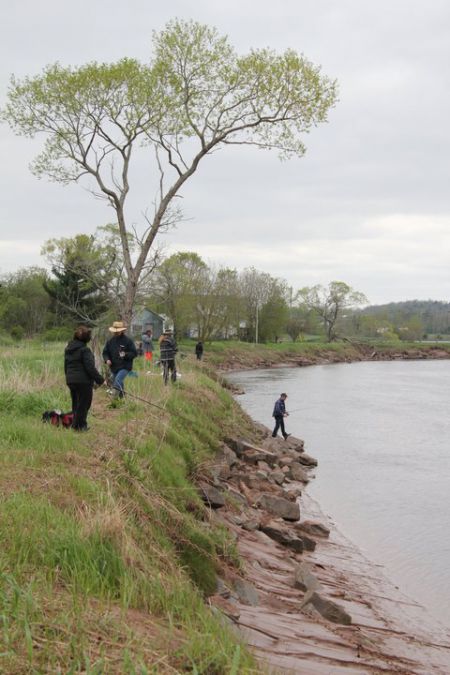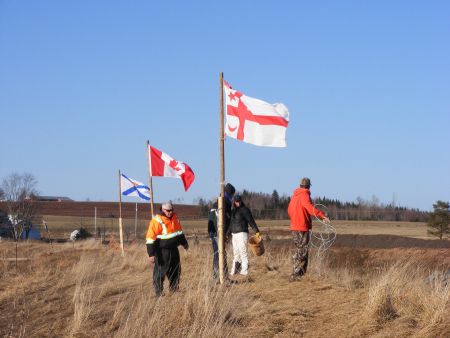The Alton Gas project plans to form three underground caverns for natural gas storage by using Shubenacadie River water injected into natural salt beds, with the removed salt coming out as brine discharged back into the river.
All the government approvals required for the project were issued this last January, the key being the Industrial Approval from Nova Scotia Environment. Construction for the brine discharge facility near Stewiacke has been completed for two years. All that remains is for the old river dyke to be dug out- allowing the river to go to the facility's intake and discharge pipes embedded in a new dyke built behind the old one.
Washing out the salt to make the 3 underground caverns is expected to take two to three years. Alton Gas could have done the final start-up in the last month, but elected to wait until “summer” to give time for more discussions, especially with Sipekne'katik First Nation that has taken the Industrial Approval to court because it was not consulted on the project. Had the project started, it would have to shut down anyway for the annual striped bass spawning period- with the required 24 day shutdown ending sometime in late June.
If Construction Was Complete, Why the Two Year Delay?
Mi'kmaq people and allies protested at the River when the opening of the dykes and the project start-up was imminent in the summer of 2014. Consultation with the Mi'kmaq has always been required, but only lip service was paid to it in the 2007 environmental assessment and subsequent attempts to force the government to pay attention to Mi'kmaq requests.
While consultation had always been required, in 2014 recent Supreme Court decisions had given the “duty to consult” much sharper teeth. So with the Mi'kmaq protests, the MacNeill government decided that it better back up and initiate some aboriginal consultation.
There was the sticky issue that the Sipekne'katik First Nation, closest to the project and whose people have always fished the river, did not give authority for consulting on it's behalf to the Mi'kmaq Rights Initiative, also known as KMKNO (or simply KMK). The government and KMK, acting for the Assembly of Nova Scotia Chiefs, chose to go ahead with consultation, and the start-up of the Alton Gas project was suspended indefinitely.
Consultation Leads to Industrial Approval For the Project
Now independent MLA Andrew Younger was Minister of Environment for part of this period, until November 2015. Younger said it was his understanding that after Mi'kmaq consultation was complete, Environment staff would proceed with finishing the Industrial Approval. Formally speaking, this is what happened. But the Environment Department appears to have played a very limited substantive role in developing what became it's final Industrial Approval for the project.
The provincial government played a bystander role in the review of scientific material carried out by KMK and it's consultants, and Prof. Duston of Acadia contracted by Alton Gas. The Monitoring Plan that became the heart of the NSEnvironment Industrial Approval, is only referred to in that document, and was authored by Duston.
The company developed Monitoring Plan was cleared with the federal Deparment of Fisheries, not with Nova Scotia Environment. The lead DFO person in this is a former student of Professor Duston. Strangely, DFO declined to participate directly in consultations with KMK, where the technical discussions took place, and which resulted in KMK requests included in the Monitoring Plan.
The only apparent contribution of NS Environment staff to the Plan is the inclusion of language about testing for NORMs (Naturally Occurring Radioactive Materials) in the brine discharge.
The Energy Department- home of the missionary Petroleum Directive- has always been the real drivers in the Alton Gas approval process. And it was Minister of Energy Samson who in January announced that all the approvals for the project would soon be granted, even though the Industrial Approval of the Environment Department is the obvious regulatory kingpin (and Energy was granting no approvals).
What About Approvals When the Project Was Ready to Start Two Years Ago ?
The brine discharge facility was even more ready to go two years ago than it is now. The last step of digging out the dyke was underway when work was suspended. When the Department of Environment spokesperson was asked about the status at that time of the Industrial Approval required for operating the facility, she answered that the Approval granted in January was the culmination of the application process begun two years earlier.
What she did not say until pressed for details was that Alton Gas did not apply for the Industrial Approval until October 2014.
An Industrial Approval takes months to process. And when Alton Gas was ready to begin brining, they had not even applied for an IA. Apparently, two months after the work was suspended the government told Alton Gas they better attend to that 'detail' while the Mi'kmaq consultation process was underway.
Alton Gas spokesperson Jeff Niuekirk confirmed that the company was indeed ready to begin brining when the work was suspended.
Department of Environment spokesperson Heather Fairbarn declined to speculate on why Alton Gas had not applied for an Industrial Approval. To the question of “whether there was some oversight or management on the part of NSE about the imminent operation of the facility"- there was no reply from the Department.




